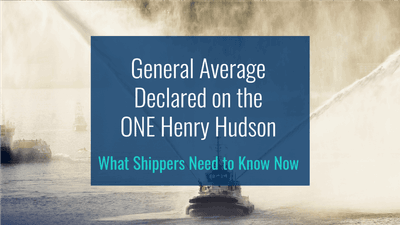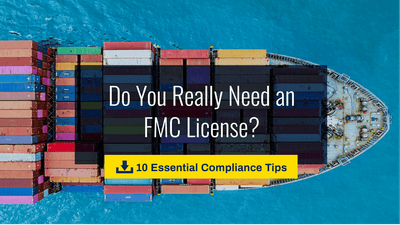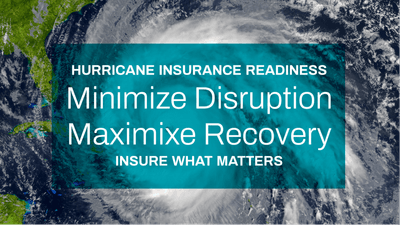May 18, 2022 | Cargo Insurance
Are You Certain Your Business Insurance is Hurricane Ready?

By Sergio Laos, ARM, CMIP
Companies involved in the logistics and supply chain industries are all too familiar with the disruption and damage hurricanes cause, including damage to their facilities, equipment, and to a client’s cargo. You cannot control where a storm may land, but you can control the financial impact to your business.
Hurricane season is fast approaching. Now is the time to ensure your emergency management and business continuity plan is ready to activate and to speak with your insurance broker to verify that your plan and your insurance program are aligned. Equally important is to speak with your clients about how to best cover their cargo while it is in your care custody and control.
Business Interruption & Extra Expense Insurance
If a hurricane causes physical damage to your facility, the right mix of coverages should be an integral component of your business continuity plan. You want the financial bandwidth insurance provides to help cover the potential loss of revenue and additional expenses you could experience in the event there is a disruption in your ability to operate from your location.
Business Interruption insurance is designed to step in and compensate you for revenue loss, payroll, and other ongoing expenses (e.g., utilities) up to a certain amount when normal business operations are disrupted by a covered incident that keeps you out of your place of business or otherwise makes conducting normal business impossible. Extra Expense insurance will step in to pay the additional expenses needed to temporarily relocate while repairs or rebuilding is taking place at your location.
For example, let’s say your logistics service operation is located near Miami International Airport. Your office building is damaged and rendered unusable due to a storm. To keep business flowing to your clients, you must relocate. You’ve already contemplated several alternative locations in your business continuity plan. An Extra Expense policy will cover expenses incurred in excess of normal operating expenses. Additional expenses may include the extra costs in rent, transporting furniture and any equipment, and even the cost of new equipment if it’s required. The policy can also pay for new phone and internet connections.
It’s important to review your policies with your insurance broker to make sure policy limits are coordinated with the parameters of your business continuity plan. For example, consider today’s high demand for warehouse space and higher rent prices. Are your policy limits in sync with today’s costs to set up at another location? Freight forwarders and other logistics service providers impacted by the storm will also face a rush for temporary office locations and increased rent in the aftermath of a storm. To minimize disruptions, make sure the limits for Extra Expense insurance are sufficiently high to help address the additional costs you will almost certainly incur.
Flood Insurance
If your commercial property is located in a high-risk flood area (Flood Zone A) and you have a mortgage from a federally regulated or insured lender, you are required to purchase flood insurance. However, even if your operation is not prone to floods, severe weather events are increasingly unpredictable and your commercial property could have a significant flood exposure. It’s important to note that about 20% of claims filed with the National Flood Insurance Program (NFIP) are for properties outside high-risk flood areas. Flood management and flood insurance should be a cornerstone for business resilience.
Cargo in Your Care, Custody and Control
The language in your contracts, invoices, and receipts is critically important to protecting your financial interests when cargo in your care, custody and control is damaged due to events beyond your control. Consistently provide your terms and conditions of service so that you can point to them in the aftermath of a catastrophic event. Despite best intentions and buttoned up procedures, you may not be able to adequately protect your customers’ cargo stored in your warehouse, in your yard, or on a truck from high winds or rising water. In this case and many others, it’s critical that your customers are aware of your terms and conditions of service which outline what you may or may not be liable for and to what extent. For example, if you are held liable, you may have limited liability (typically 50 cents per pound). Have your clients acknowledge these terms in writing to avoid any disputes down the line.
Maintaining Cargo Legal Liability or Warehouse Legal Liability insurance is highly recommended to preserve your financial interests. If clients want to insure their cargo for damage from a hurricane or flooding, offer them the option to purchase Bailee Coverage and All Risk Cargo insurance. A customer can even purchase this coverage ahead of an impending storm. However, once the storm is “in the cone” and set to hit land, coverage usually cannot be purchased.
Cargo insurance also provides coverage for physical loss or damage to cargo while enroute to its final destination. Most policies will offer a consolidation/deconsolidation timeline that extends coverage for 30 days. If a storm delays the delivery of the cargo to its final destination, you want the flexibility of having this timeline extended, perhaps even to 60 days, to protect the cargo from damage or theft.
There are countless stories of lost or damaged uninsured cargo in flooded warehouses, trapped on trucks during a flash flood, or in temperature-controlled warehouses that lost power leaving cargo owners with no recourse. Help make your clients aware of this unnecessary financial risk and its simple solution – shipper’s interest cargo insurance.
Beef Up Your Business Continuity Plan, Be Sure You’re Insurance-Ready
Last year eight hurricanes slammed the U.S. coast along with 21 named storms, making 2021 the third most active year in history, according to the National Hurricane Center. Experts predict another active season for 2022, pointing to the 19 named storms in the Atlantic Ocean, Caribbean Sea, and Gulf of Mexico, of which four are expected to become major hurricanes with sustained winds of at least 111 miles per hour. We recommend reviewing your business continuity plan and ensuring you have the right coverages in place before hurricane season hits.
About the Author:
Sergio Laos, ARM, CMIP
Vice President
Sergio Laos has been in the marine insurance industry for more than 25 years and is located in Roanoke’s Miami office. During his career, Sergio has held roles as both a broker and underwriter. This experience provides him with a special understanding of insurance placement pitfalls. In addition, his hands-on knowledge of the Latin American insurance market provides a rare ability to overcome the common obstacles faced in the South Florida region.
Disclaimer: The descriptions of coverage described above are generalized and are subject to the specific policy’s terms, conditions and exclusions. For full coverage details, please refer to the actual policy forms. This content is not an offer of insurance nor does it provide insurance coverage to the reader.













